CONTENTS
(Over 6,000 words)
Introduction
But what about all the
mammals?
Different Routes Below
Great Passageways
or Holes to the Inner World
Floating Continents and
Plate Tectonics
Floating Continents
on the Inner World Too?
A Matter of Gravity
Geological Chicken Soup
For the Soul
Geological
Vortex, Whirlpools to the Other Side
Dinosaur Islands,
Lost Valleys, Forbidden Plateaux
Vortices on Land, the Lost
Worlds
A Lighter Look at Gravity
Introduction
All right then: Pellucidar is full of dinosaurs. And
we mean, chock full of dinosaurs, we got our pteranodons, our plesiosaurs,
our itchysaurs, we got honest to goodness flying stegosaurs, carnivorous
triceratops, iguanodons, hadrosaurs, you name it, Pellucidar has it.
We got dinosaurs that ain't even in the fossil record, like Mahars and
Snake men. On top of that, we got your A 1 selection of prehistoric
mammals, including mammoths and sabre tooth tigers and megatheriums, which
you can't even get at Wal- Mart no more. We got us a full roster
of human and semi-human lineages, including every kind of ape you can think
of, bolganis, manganis, ape men, monkey men, cave men and even corsairs,
and everyone knows that corsairs don't count as prehistoric unless you
happen to be from California.
Basically, Pellucidar is your one stop shopping centre for all your
prehistoric needs. Forget Maple White Land, dump Caprona, don't
even think of Skull Island, and bypass Pal Ul Don unless you're going for
the neaked seal furred chicks to tich em bible studdies, if you know what
I mean, and I'm sure you do. How do we offer such a great deal on
prehistoric prehistory? Volume, ladies and gendermen, Volume, Volume,
Volume. Pellucidar, being on the inside of the planet, and
with the continents and oceans reversed, is at least sixty or seventy per
cent land and, being such, actually has way more land area than the topside.
That's a lot of storage space for those big ass prehistoric critter, no
matter how big their dino-bottoms are.
So... Here's the problem: How did they
all get down there, unto the undersides of the Earth?
Took a cab? Pellucidar please, and step on it?
I mean, think about it. Okay, sure there are openings at the Earth's
poles. But here's the thing, it's damned cold up at those poles.
Icy even. You've got glaciers everywhere you look, there's
no vegetation for hundreds of miles, and even the polar bears and penguins
think it sucks.
You look at penguins, they're just depressed, you can tell.
There they are, standing on ice floes, looking out at more ice floes, and
you can tell they're not happy about it. Then sometimes they
look down into the cold cold water, and basically they're thinking “I have
to go in that???”
Polar bears, same thing, you can tell by the way that they drag their
carcasses through life, they're just putting in their time.
Deep down, all any polar bear wants is a case of grecian formula 16 and
a one way ticket south so they can go kick grizzly ass and settle back
to the good life.
So, all these land before time style incredible journeys may be all
well and good if you're a baby dinosaur who wants to get in on a franchise
of a well loved set of children's movies. But if you're a full grown
dinosaur with sense, the one thing you know is that you don't mess with
them what's bigger than you are. And no matter how big a dinosaur
you are... A glacier is still bigger.
I mean think about it. You're a dinosaur, you're making that trek
north, getting down with the ice floes? What the hell are you
going to eat? The only greenery is buried under a quarter mile of
ice, and its past the sell by date! What's the motivation here?
Sure, you can eat the dinosaurs that are stupid enough to visit, but really,
that's going to get old really quick. There's nothing to attract
the herbivorous ones to the area, except the twin attractions of being
eaten or being frozen. Frankly, the last theme park that used
that as an attraction went out of business doubleplusfast damned quick.
It's not like they're walking around with a secret dinosaur map saying
‘eternal paradise here’, so how are your common ordinary herbivorous dinosaurs
going to be motivated to wander six months around antarctic or arctic wastes,
just on the off chance that a few of them are going to stumble inside and
populate the underside? An underside they don't even know is
there, because, let's face it, they're dinosaurs... they've got brains
the size of an Alabama redneck's heart, sometimes even smaller.
Okay, you tell me. “But I gotta remember the climate and the continents
were different back then, and you know, we were probably doing without
all those ice caps and glaciers, the land of the midnight sun was a pretty
nice tourist destination and everything, and they all just walked in.
Hell, maybe the polar openings weren't even at the poles then, maybe they
were around the sides and it was so nice dinosaurs were just walking in
and out without even noticing.”
Okay. Maybe. Maybe the ice caps were there, and maybe they
weren't. Maybe the poles were cold and inhospitable and maybe they
weren't.... In the time of the dinosaurs. We weren't around
much for that, so you can say any fool thing and I cant prove you wrong.
But
what about all the mammals?
Because we know when the age of mammals rolled around we were definitely
getting snow. The polar caps were cold and frozen, the polar
holes were right there, it was party time for glaciers. Yeppers,
remember all them ice ages?
So maybe if you were doing the footwork of a monkey in a square dance
contest, I'd let you get away with the dinosaurs. But mammals?
No way. And there's all sorts of prehistoric mammals in Pellucidar.
Now some of them, we could get away with, maybe. You take your
big basic woolly mammoth. They're like the hummers of the ancient
world. They'd be good to go. Now, they were basically
boreal forest critters, but in a pinch, they could make the journey across
the white wastes. No good reason for them to do it, but they
could.
But take the giant sloth, Megatherium. Refused to go any
further north than California. New Mexico, fine. Arizona,
fine. Texas, the needed a place to crap. Florida, they
bought the swampland. But Oregon? No way. New Jersey?
Fugeddaboutit. Canada? No way, they'd seen what happened to
the polar bears and weren't making that mistake.
So here's the problem with Pellucidar. It's chock full of
hothouse species that couldn't possibly have gotten in through the polar
openings. But they're there, so how did they get there?
Different
Routes Below
Well, one possible theory is that they were there all along, and in
fact, life on the inside and outside of Earth naturally evolved in the
same way, producing the same creatures. Now, this is taking
the very normal and accepted concept of Parallel Evolution to new and dizzying
heights. Frankly, I could spend a lot of time on this. But
instead, I'll just note that there is a technical term for this theory:
Really stupid.
Well, how about crawling through volcanic vents, just like that Perfesser
Fella and his crew did in Journey to the Centre of the Earth, by Jules
Verne. Okay. Sure. Could happen.
Let's say there's only about 500 or a 1000 miles between the inside
and outside. Of course, that would be a straight drop.
So really, the path is kind of sloping and winding, let's say 2500 to 5000
miles. At that rate you're traveling with a 20% grade, or down
(and later up) a 36 degree slope... Which is pretty damned steep,
but traversible. Of course, if we were looking at 5000 to 10,000
miles, it would only be an 18 degree slope, which would be a lot easier
but a lot longer. For a shorter trip, you might cut it down
to 25 or 500 miles, but then with a 72 degree slope... Well, I hope
you packed air bags, you're going to need them.
Anyway, the problem with this volcanic tube connection is its just too
long. You ask your average critter to take a 1000 mile journey,
including some very steep traveling, without even a box lunch...
Well, its not going to be fast. No critter is going to run,
its going to be a lot of walking, a lot of sleeping, a lot of complaining,
wandering around, getting lost. So assuming they make good
time of about 20 miles a day, which would be really good. It
would only take 50 days to make it into Pellucidar.
How many animals are going to be travelling for roughly two months without
a hearty meal? And the last we heard, there wasn't a lot of
nutrition in cold lava. Now true, there are long distance haulers
out there who can go weeks or even months, hard core migrators.
But there are way too many hothouse critters in Pellucidar who aren't migrators
and whose ancestors were not migrators.
Besides which, there are certain physical limitations. How
the hell is a Triceratops or a Woody Mammoth or a Megalotherium going to
navigate 5000 miles of volcanic tube. Even with liposuction, its
pretty unlikely they'll squeeze all the way through. Nah, you
might get a lizard showing up once in a while, but that's about it.
So, how are they getting there? To explain that, we
have to go back to first principles and come to grips with the way that
Earth and Pellucidar are working.
Great
Passageways or Holes to the Inner World
The proliferation of prehistoric species, including hothouse prehistoric
plants and animals of suggests that perhaps there are or were other major
holes opening from time to time in other parts of the globe? Big enough
and open long enough for entire ecosystems of dinosaurs or prehistoric
animals and plants to make the transition inside in sufficient numbers
to establish viable breeding populations.
How would that work? Obviously, there are no such holes around now,
except at the poles. And if these other holes opened up, then
given the current 3 to 1, ocean to land, ratio of surface area on Earth,
then its likely that some or several of them opened in the ocean.
Assuming one of these holes opened in the Pacific, for example? then
why do we still have an ocean? And why isn't Pellucidar flooded?
Well, gravity obviously. Burroughs establishes
that local gravity curves, so that to the traveler, you're always flat
on your feet, right side up. So a hole in the ocean would only result in
Pellucidarean and Terrestrial seas mixing, not one draining the other.
In fact, you might not even notice yourself sailing through the hole into
the Pellucidarean sea. You'd merely notice a spell where the horizon
seemed shorter than usual, because you were sailing over more extreme curvature.
All right, so there may be other holes which open. And since
these would be major holes, and since we don't see any of them now, we
have to assume they're somewhat temporary. How does that work?
Floating
Continents and Plate Tectonics
Try this. Our world has evolving geography, plate tectonics, etc. The
continents move around, essentially on an under structure of crust or mantle
which acts like a slow liquid. The underlying composition of
Earth is simple rock, but it is rock under immense weight, heat and pressure.
So that over extremely slow time, it will shift and flow. The
continents sit around on top of that stuff, and like floating pie plates
on a kiddy swimming pool, they drift around slowly, occasionally bumping
into one another.
Meanwhile, however, on Burroughs Earth we've got a different geography.
The planet is hollow, and the arrangement of internal continents is a sort
of loose reverse mirror of the external. Thus, the area of the Pacific
is a continental area. The area of the Himalayas is a deep sea.
But why this? If we go by the Innes expedition, then the thickness of
the Earth must be hundreds, even thousands of miles before we get to Pellucidar.
There's no special reason why the continents and oceans should be reflected
in counterparts at all, at least, not in the sense of the inner
ones being the undersides of the outer ones. Rather, they would
probably be separate, but perhaps linked structures.
So, does Burroughs world have plate tectonics? It's got
all the features of plate tectonics, including mountains, valleys, uplifts,
earthquakes and volcanoes, all of which are caused by plates bumping and
separating in different ways.. And the shape of the outer continents is
the same.
So if Burroughs Earth doesn't have plate tectonics, we have to explain
why it has all those ‘tectonic features like Mountain ranges and volcanic
islands. And more than that, how a ‘non-plate tectonic world’
managed to produce a configuration of continents and geography so nearly
identical to our own plate tectonic world.
I say ‘nearly identical’ because obviously, there are a number of small
scale geographical differences between Burroughs world and our own...
Africa's geography seems to contain far more opportunities for mountains,
tablelands and hidden valleys, for example.
But that's a digression. For the most part, we have identical
geography and the same sorts of features, so we'll have to assume it does.
Floating
Continents on the Inner World Too?
But how about the underside, Pellucidar? Does Pellucidar
too have plate tectonics like the upper earth, or is it a place of stable
geography like Mars or Mercury?
According to Burroughs hand drawn maps and his descriptions of the geography,
it seems that Pellucidar too has mountain ranges, cliffs, continental uplifts,
volcanoes, etc. These are all features of plate tectonics.
So, absent another explanation for these features, we have to assume that
plate tectonics are at work.
Which means that the Pellucidar land masses are floating around just
like the topside ones. And actually, that would make the mountains
and valleys steeper, because everything is moving around an inside curve,
its moving faster and piling up higher.
With more rapid movement on an inside curve, you'd expect the plates
to be smaller and more broken up. So instead of continent and subcontinent
sized plates like Europe, Asia, South and North America, we would tend
to see smaller plates like Madagascar or India. You would probably
still get ‘continental masses from the plates jamming together, as in fact
India, Asia and Europe are jammed together to form a Eurasian supercontinent.
But you'd probably have within the Pellucidarean continents, strong separations
of the small plate components by sheer cliffs, savage mountain ranges,
or angry seas. More on that later.
But what does this, however interesting, have to do with anything?
Here's where it might get interesting. If Pellucidar
and topside have plate tectonics, then that means that on both sides, what
we have are big flat continental and subcontinental masses floating around
on an intervening pseudo-liquid crust/mantle. Solid rock, as
I've said, but under so much heat, pressure and weight that over vast periods
of time, it behaves almost like a liquid.
A
Matter of Gravity
On the moon, there are these things called Mascons. Ever hear
of them? Well, it turns out when they were flying the space probes
out there, that the Moon's gravity was variable. Certain areas of the moon
had heavier gravity than other areas. Not by much, but noticeable to fine
instruments, and particularly significant to orbital dynamics. It seems
that heavy or massive areas on the moon, could in fact, create local variations.
What this teaches us is that a planet's mass is not uniform, but that
it is possible for that mass to be unevenly distributed to the point where
it affects local gravity. Now on Earth, the overall
mass of the planet is so distributed that the continents mass really doesn't
have any kind of significant or measurable effect on either the other continents
or on the local gravity. On Earth, our gravity is exerted all
the way from the core.
The thing is, On Burroughs Earth, local gravity is exerted essentially
by the space or mantle between inside and outside. The centre
of gravity for a hollow world, and the source of gravity, is the centre
of the space between the inside and outside surfaces. Perhaps
a larger gravity holds it all together... But Pellucidareans don't have
to hold onto the rocks to keep from falling into the sun.
Back to our hollow world. The continents on the inside and outside are
floating around. Pellucidar has gravity, the outside has gravity, everyone
is happy. But what this means is that the local mass, or local
gravity, is actually pretty vulnerable. The continents themselves represent
huge flat, gravitational pancakes on each side. The composition
of Burroughs Earth has a radically different distribution of mass, which
means that the relatively trivial mass of the continents may actually have
subtle gravitational effects.
They would not be enough to significantly affect the overall gravity.
Possibly, we might see slightly less gravity at sea, or the seas pulled
slightly higher around continental shelves. These effects,
however, might be so slight as to not be measurable except by very sophisticated
instruments. But perhaps enough gravity for the continental plates
to have tidal effects on each other? After all, looked at in
one way the moon doesn't really affect gravity on Earth. No one has ever
fallen to the moon, or been lightened a few pounds or ounces by the moon.
But on the other hand, the moon's gravity does affect the Earth in the
form of tides, and tides are significant.
So, you could have slow moving continental masses on the inside and
outside, pulling on each other. The inside masses wouldn't affect, or significantly
affect, other inside masses, because their geography is edge on,
and the centres of gravity are weakest at the edges. The same
would hold with outside the outside plates affecting each other.
But continental plates on the inside and outside would literally be face
to face with each other. Which means they're both moving, and both
affecting each other. If they're both moving, then the
internal and external geography is constantly reshaping. Geological speeds,
so its incredibly slow, but its there.
However, the subtle gravity of the continental plates topside might
well have an effect on the subcontinental and island plates of Pellucidar.
An obvious effect? Not one you could easily measure, but on
a time scale of tens or hundreds of millions of years, the continents on
the outside and particularly the smaller plates on the inside would be
drawn and shaped by each other.
The effect would be similar to magnets on two sides of a sheet of paper.
Move the magnet on one side, and the magnet on the other side is drawn.
Except here, instead of strong magnetic forces, we're using weak gravitational
influences over a vast time frame.
The outer side continental plates, being larger and more massive would
be less influenced by the underside plates. You probably wouldn't
see a big difference between the Burroughs world geography and ours.
But you might see small puzzling divergences, such as more and bigger mountain
ranges and valleys in Africa.
On the inside, you might see the smaller plates being drawn together
into parodies or reflections or even inversions of the exterior shapes.
Being smaller, less massive and faster moving, they'd be more likely to
be influenced in their shape and formations.
Very well. So we've got continental plates floating around
on both sides, and over large time scales, their local gravities are affecting
and shaping each other. So what? The thing is, that we're
forgetting about the crust/mantle medium they're both floating on.
That semi-liquid medium of dense, pressured, molten rock, call it geological
soup.. That stuff is still there, still semi-liquid, still
floaty and full of currents. Except now, there are major continental
or subcontinental plates on both sides, inside and outside, to stir our
geological soup.
Geological
Chicken Soup For the Soul
On Earth, our geological soup is stirred by heat from the core.
On Burroughs world, it occurs at least in part through the interactions
of the plates on either side. What do you get when you stir
soup, even geological soup? Well, you get currents.
But more than that, the more complicated the stirring process, such as
as multiple continent plates on both sides swinging each other around,
the more interesting the currents that you get.
In particular, you get fun things like eddies, ripples, turbulence,
sometimes waves. Wouldn't mean anything if you're sitting safe
on the continental plates. Except that sometimes, there might,
over a few thousand years, be a higher rise or drop. Your inland
city is underwater, poor Atlantis, or your coastal town is now in the highlands,
hello Tiahuanaco or Opar.
In the oceans, you might have odder phenomena, again, not terribly noticeable,
except that perhaps you'd find more mysterious temporary islands and land
showing up in odd places for as short as days or as long as a few thousands
of years before subsiding, things like that. In short, the
divergent effects would be things similar to what we are actually seeing
in Burroughs world.
Geological
Vortex, Whirlpools to the Other Side
But most importantly, we will get circular currents.
And circular currents produce whirlpools, or vortices. What
you might get, potentially, out of the continental plates on both sides
interacting is thin spots where they are drawn together, and gigantic,
immensely slow vortices, geologically slow vortices which might open up
like a whirlpool, creating a huge temporary opening or passageway between
the outer and inner worlds.
Such a vast opening might last dozens, hundreds or even thousands of
years before closing up. It would not be perceived as a hole
by those on the ground, of course. They are subject to local
gravity and perspectives. As they walked into the hole, from
one side to the next, they would always feel they were right side up, gravity
would work, down would be comfortably beneath their feet. It
wouldn't feel like a passage from one world to the next, it would simply
seem a normal journey.
At best, the horizon might appear to shorten, and the sky would look
strange, with bizarre cloud formations, illusions of a land in the clouds,
the sun being in the wrong place or acting strangely, perhaps even two
suns. Magnetic compasses would become unreliable. The experience
would be disorienting. Interestingly, these are all effects
reported by early Arctic explorers, who in Burroughs world, must have been
skirting the polar openings. Even today, the phenomenon of
sun dogs (two or more suns), and other upper atmosphere illusions is well
known and well reported by travellers in the north or on the open sea.
And in fact, these are the same sorts of effects noticed by early seamen
from the days of sail, or from certain planes flying in the Bermuda triangle
during the 50's and 60's. Based on this, we might assume that
in Burroughs world, the Bermuda triangle, and other such cursed sea regions,
were actually occasions of temporary holes or openings or vortexes to Pellucidar.
Those unwary sailors or airmen who ventured into them would experience
the effects described and either find their way home, or wind up in a strange
land with a permanent day. Indeed, in Burroughs world, this
seems to be what happened to David Innes corsairs, who appear to be descended
from renaissance era European pirates.
There are more hints that this is what is actually going on in Burroughs
world. Take Caspak, or for that matter, King Kong's Skull Island
(I know that Burroughs did not write it and technically, King Kong is not
in Burroughs world, but he certainly was a writer of that time, and may
have inspired and taken inspiration from such materials, at the very worst,
Kong and Burroughs took inspiration from the same sources and used the
same kinds of ideas).
Here's the interesting thing about the sea. It's flat.
It's damned flat. Pancake flat. On the sea, the view is terrific
because there is nothing to get in your way. Sight lines are
unobstructed from every direction.
This makes islands easy to spot. They kind of stick out,
if you know what I mean. They're obvious, they're a bump on
that smooth flat horizon. The only thing that conceals islands
is the curvature of the earth. For a man standing on a plain,
the horizon is six or seven miles away. From a higher elevation,
such as a ship, or a crows nest, one can see much, much further.
The result was that during the age of exploration, sailors and seafarers
showed a remarkable knack for finding every little island, shoal, reef
or piece of rock in large swathes of empty ocean. In fact,
the endless view from the crows nest allowed one to spot whales over vast
distances and therefore to track and hunt them nearly to extinction.
So, if you had something like Caspak, which is roughly the size of Jamaica,
or King Kong's Skull Island which has to be relatively large to support
the population and sizes of dinosaurs, giant apes and ancient ruins that
we see, well, it would be impossible to miss. It would stick
out on the horizons from large distances. Neither of these
islands are low lying wallflowers clinging to the horizon, Skull Island
has a massive volcanic mountain while Caspak is bounded by high cliffs.
Basically, they tend to stick out.
So, on conventional geography, it's all but impossible that these islands
would not have been discovered before the 20th century. But
nevertheless, here they are. Caspak is not encountered until
WWI, and even then, its accidental. Skull Island is not visited
until the early 30's. That's just not on.
Unless these islands were actually within the vortices.
If that was the case, then they would be hidden beneath the normal curvatures
of the Earth. Technically, their elevation would be below normal
sea level. This would make them almost undetectable, sailors
would literally have to be almost on top of them before they'd be spotted.
In fact, sailors would have to venture at least part way into the vortice,
and experiencing the strange effects of foreshortened horizons, unreliable
magnetic compasses, the sun being in the wrong place, two suns, absence
of stars and strange skies. Any normal seaman venturing into
that would instinctively want to get the hell out, normal navigation by
sun, stars, compass or sextant simply wouldn't be possible.
Thus, these areas would tend to be avoided by sailors on general grounds,
and even when entering these areas, they would have difficulty finding
their way and be far more concerned with getting back out.
Which would mean that they would easily escape notice or charting for
quite a long time, and any records of them would be unreliable simply because
cartographers would not understand the geography. They'd be
trying to place the island on a ‘flat globe’ without recognizing the extreme
distortion of curvature of vortice. The result would be a worthless
map, you'd never find it that way again. The best you could
hope for is to wander into the area blunder around until perhaps you found
it and then hope to blunder out again.
Dinosaur
Islands, Lost Valleys, Forbidden Plateaux
Of course, one notable tip off that places like Skull Island and Caspak
might actually be connected to Pellucidar would be the distinctively Pellucidarean
flora and fauna. Dinosaurs and cave men, prehistoric mammals,
all often outsized, and all from differing geological time periods, somehow
co-existing.
In fact, there were often reports of these mysterious lost worlds in
remote locations with bizarre mix and match of prehistoric creatures.
Burroughs Pal Ul Don is another example, mixing creatures from different
continents and time periods. Conan Doyle's Maple White Land
in South America mixed dinosaurs with hominids and proto-hominids.
(Caspak, notwithstanding its apparent weird internal evolutionary biology,
fits the overall Pellucidar island theory. The various sorts of prehistoric
creatures obviously are either spontaneously generated (all but impossible),
or more likely were originally derived from elsewhere. Although
Caspak's novels make no explicit reference to other Burroughs series, {Tarzan
visits the Earth's Core, meaning that his world is also the one containing
Pellucidar, meanwhile, Barsoom communicates with Earth by Pellucidar’s
Gridley Wave, which means that Barsoom is in the same universe with Tarzan
and Pellucidar, and Carson of Venus was originally aiming for Barsoom,
meaning that Amtor, Barsoom, Pellucidar and Tarzan are all in the same
reality. Only Caspak is the odd man out, and even there, the profusion
of prehistoric fauna seems to connect it with Pal Ul Don and Pellucidar.
.... Random thought, I wonder if the Wieroo are in any way related
to the Mahars?})
There's an inherent problem in these bizarre mixes and matches.
How on earth do they mix and match, how do creatures which never existed
on the same continents, much less the same time period wind up together.
And why do we find these ‘mix and match’ ecologies over and over again.
If they were all isolated, one would expect much simpler and more coherent
mixes of fauna. The large mixing and matching suggest that these
islands or valleys somehow draw their animals and humans from large geographically
and temporally different sources. The number of places suggests
that in fact, they are all drawing their fauna's loosely from a common
source. This suggests the existence of a meeting point, a mixing
area where the various species would naturally be gathered.
The pulp writers of Burroughs era were often writing of dinosaur islands
in the Pacific or Indian Ocean, or hidden plateaus and valleys of dinosaurs
or strange life tucked away in Asia, Africa or Antarctica.
Likely, at least some of these pulp discoveries were the same lands or
islands. Remember that in the vortices, these places would
be impossible to coherently chart or locate on maps according to spherical
cartography, thus they could be discovered, lost, re-discovered by others
from different angles or directions, lost again and discovered all over
again. There are actually far fewer of these areas than the reports
would suggest.
Skull Island might have been found a handful of times by seamen and
aviators, each of whom believed that they were making and independent discovery,
without realizing, even if they were aware of other journeys, that the
were all visiting the same island.
But why would all the islands in these sea vortices be only Pellucidarean
Islands or bits of Pellucidar territory. The answer is simple:
They're not. Topside islands or bits of territory would wind
up in or on the edges of the vortices. But let's face it, you're
a seaman, you wander into a strange area where conventional navigation
doesn't work, and you find a mysteriously undetectable island inhabited
by.... Goats? Who cares. Dinosaurs?
Now you're talking. Polynesian Islanders? Big deal.
Ape men? Stop the presses!
Given the proliferation of discoveries like Pal Ul Don, Caspak, Skull
Island, Maple White Land and others, I think that if Pellucidar had not
been discovered, then the diligent archeologist of unreality would be forced
to hypothesize the existence of such a place, either within the earth or
some other adjacent dimension.
Vortices
on Land, the Lost Worlds
On the ocean, the vortices or temporary openings to Pellucidar would
be treacherous and near impossible to find... Until it was too late.
What about on land? What would the character of these vortices
be? Well, likely you would find them at the edges or
joinings of continental plates, so you'd look in places like the edges
of the Andes, the Himalayas, the Olduvai Gorge or the anomalous African
mountain ranges or chasms which apparently exist in Burroughs Africa (and
likely in parts of Asia and Africa, but rather less likely in the standalone
American continents).
More interesting, we could expect that on land, these vortices would
be reflected as extreme local uplifts, a kind of ‘wave’ or ring of disordered
distorted territory. A vortex ring. Hence, they
would tend to become surrounded by impassible mountains, cliffs, uplifts,
jagged chasms, etc. At least on the topside, it would be like
this. The larger upper plates have more mass and more inertia,
so the geological effects would tend to pile up in a smaller area.
The result, of course, would be the high uplift and cliff faces of Maple
White Land in South America, or the jagged barriers of mountains, cliffs,
chasms and swamps that ring Pal Ul Don. And given the slower
geology topside, they would tend to last longer.
On the other side, the Pellucidar side, the plates are smaller, less
massive and more flexible. You would see, as part of the vortice,
geological distortion, but this would be more diffused across the plate,
and because Pellucidar’s plates were moving more quickly, the vortice rings
that did develop would not last as long. Thus, you wouldn't
necessarily get an impassible geological barrier, and eventually the topside
species trapped within would escape or be released to spread through Pellucidar.
Thus, the mechanics of these vortices, particularly on land, would tend
to operate as one way passages. It would be very easy for topside
animal and plant populations gradually trapped within the area of these
vortices to find their way into Pellucidar. It would be very
difficult, however, for animal populations from Pellucidar to escape into
the outside world. Mostly, they would be confined largely to
the immediate areas of the vortice.
Does this mean that we could travel to Pellucidar from Maple White Land
or Pal Ul Don? Possibly, or at least, once upon a time.
Remember that the vortices are geologically temporary phenomena.
Maple White Land, Pal Ul Don and other dinosaur valleys or plateaus probably
represent the remains of former vortices, still ringed by their mountains
and cliffs, with small trapped relic populations of Pellucidarean life.
They are literally, Islands of Pellucidar trapped on the surface.
If we studied the geology of Burroughs world carefully, we might find
the scars of other places on land where Vortices existed, and perhaps there
might be an occasional cryptid species that managed to escape their Vortex
ring to live on the remote margins of the outside world.
Probably, given the lack of any major recolonisation of the surface
by Pellucidar species, places like Pal Ul Don, Maple White Land and Skull
Island are flukes. Most often, I would assume, the vortex area is destroyed
geologically by the vortex closing. Instances of stable territory are probably
rare, and over the long term, not viable. Thus, there are only a few 'lost
worlds', of relatively small size and relatively vulnerable to disaster.
Thus, while its easy for topside species to find their way under, its
difficult for Pellucidar species to get out. The traffic is
almost entirely one way. There may be other factors at work,
Pellucidar might have a slightly lighter gravity (for reasons discussed
later), or a more benign oxygen rich atmosphere, so that the air quality
and gravity also help to form a species barrier. Places like Pal Ul Don
may be the rare occasions when traffic has gone the other way. And it clearly
hasn't gone very far.
A
Lighter Look at Gravity
Actually, Pellucidar probably does have lighter gravity. The transition
from outside to inside is so gradual, it wouldn't be noticeable to the
traveller it, but there would be a difference. That's probably why Pellucidar
can support much larger flying or gliding critters. And it's
probably why the birds, pterosaurs, bats and other flying creatures of
Pellucidar cannot simply escape through the vortex into the outside world.
For most Pellucidar animals, the slightly higher gravity of the topside
world simply means that they have to work a little harder and get tired
more easily. For flyers, it's a major handicap. It means
that they have to work harder, they fly less quickly, less gracefully and
with less range. They're casually outperformed by the swifter stronger
smaller flyers of the outside world.
Why lighter gravity? Because of Pellucidar's sun.....

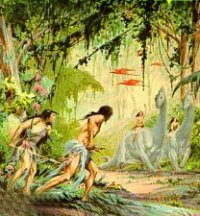
![]()
![]()
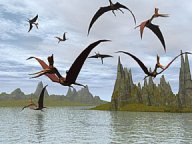

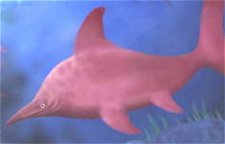
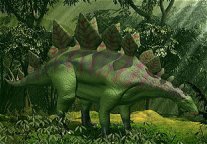
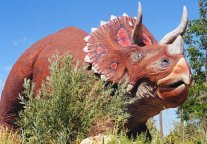
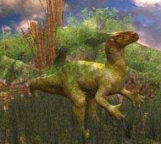
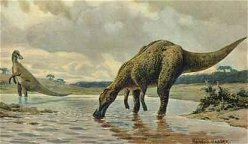
![]()


![]()
![]()







![]()
![]()
![]()
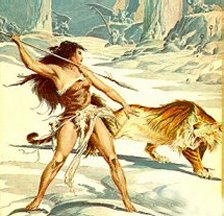
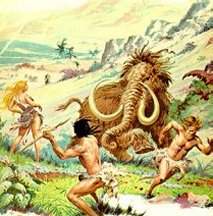
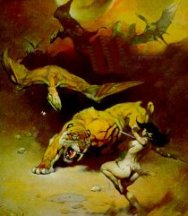

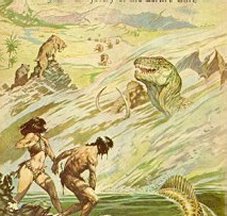


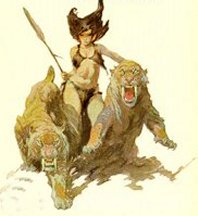



![]()
![]()
![]()
![]()

![]()